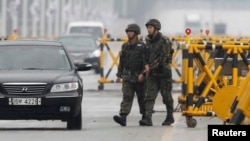Foreign diplomats stationed in North Korea appeared to be staying put at their embassies in Pyongyang Saturday, despite the government's public suggestion that they should leave the capital for security reasons.
Reports received in Western capitals from foreign embassies in Pyongyang indicate diplomats are disregarding the warning to leave, and that most foreigners saw the warning message North Korea circulated Friday as a gesture intended to heighten tensions on the Korean peninsula.
North Korea had told embassies and international groups it could only guarantee their safety until April 10 in the event of open hostilities.
Russia and Britain said Friday they had no plans to evacuate embassy staff.
Meanwhile, more South Koreans who work at an industrial complex inside North Korea - a commercial project that both Seoul and Pyongyang have supported for years - return across the border to the South Saturday, several days after Pyongyang said it would block South Korean access to the facility. Up to 500 South Koreans are believed to still be at the Kaesong industrial complex, which is believed to be the main source of hard-currency income for Pyongyang.
North Korea has threatened military action against both the United States and South Korea in recent weeks, unless the outside world stops pressuring North Korea to end its nuclear weapons program. North Korea has claimed it has the capability of launching nuclear weapons. Although the reclusive government in the north has made advances in nuclear weapons technology, most military and diplomatic experts doubt that Pyongyang has the ability to launch such attacks far beyond its borders.
Reliable reports in the region indicate that Pyongyang has deployed two intermediate-range missiles on mobile launchers near the country's east coast, and U.S. defense officials tell VOA they have been preparing for another North Korean missile launch in the coming days.
North Korea will mark the birth centenary of its "founding father," Kim Il Sung, on April 15 with pomp and ceremony and displays of its military strength. Kim Il Sung led the communist country from 1948 until his death in 1994. His grandson, Kim Jong Un, currently holds power in Pyongyang.
Some information for this report was provided by AP, AFP and Reuters.
Reports received in Western capitals from foreign embassies in Pyongyang indicate diplomats are disregarding the warning to leave, and that most foreigners saw the warning message North Korea circulated Friday as a gesture intended to heighten tensions on the Korean peninsula.
Tensions Rising on Korean Peninsula
Tensions Rising on Korean Peninsula- February 12: North Korea carries out third nuclear test
- March 27: North Korea cuts military hotline with South Korea
- March 28: U.S. B-2 bombers fly over Korean peninsula
- March 30: North Korea says it has entered a "state of war" with South Korea
- April 3: North Korea blocks South Korean workers from Kaesong
- April 4: North Korea moves a missile to its east coast
- April 9: North Korea urges foreigners to leave the South. The U.S. and South Korea raise alert level
- April 14: US Secretary of State John Kerry offers talks with Pyongyang if it moves to scrap nuclear weapons
- April 16: North Korea issues threats after anti-Pyongyang protests in Seoul
- April 29: North Korea holds back seven South Koreans at Kaesong
- April 30: North Korea sentences American to 15 years hard labor for hostile acts
- May 20: North Korea fires projectiles for a consecutive third day
- May 24: North Korean envoy wraps up China visit for talks on Korean tensions
- June 7: South Korea accepts Pyongyang's offer of talks on Kaesong and other issues
Russia and Britain said Friday they had no plans to evacuate embassy staff.
Meanwhile, more South Koreans who work at an industrial complex inside North Korea - a commercial project that both Seoul and Pyongyang have supported for years - return across the border to the South Saturday, several days after Pyongyang said it would block South Korean access to the facility. Up to 500 South Koreans are believed to still be at the Kaesong industrial complex, which is believed to be the main source of hard-currency income for Pyongyang.
North Korea has threatened military action against both the United States and South Korea in recent weeks, unless the outside world stops pressuring North Korea to end its nuclear weapons program. North Korea has claimed it has the capability of launching nuclear weapons. Although the reclusive government in the north has made advances in nuclear weapons technology, most military and diplomatic experts doubt that Pyongyang has the ability to launch such attacks far beyond its borders.
Reliable reports in the region indicate that Pyongyang has deployed two intermediate-range missiles on mobile launchers near the country's east coast, and U.S. defense officials tell VOA they have been preparing for another North Korean missile launch in the coming days.
North Korea will mark the birth centenary of its "founding father," Kim Il Sung, on April 15 with pomp and ceremony and displays of its military strength. Kim Il Sung led the communist country from 1948 until his death in 1994. His grandson, Kim Jong Un, currently holds power in Pyongyang.
Some information for this report was provided by AP, AFP and Reuters.










